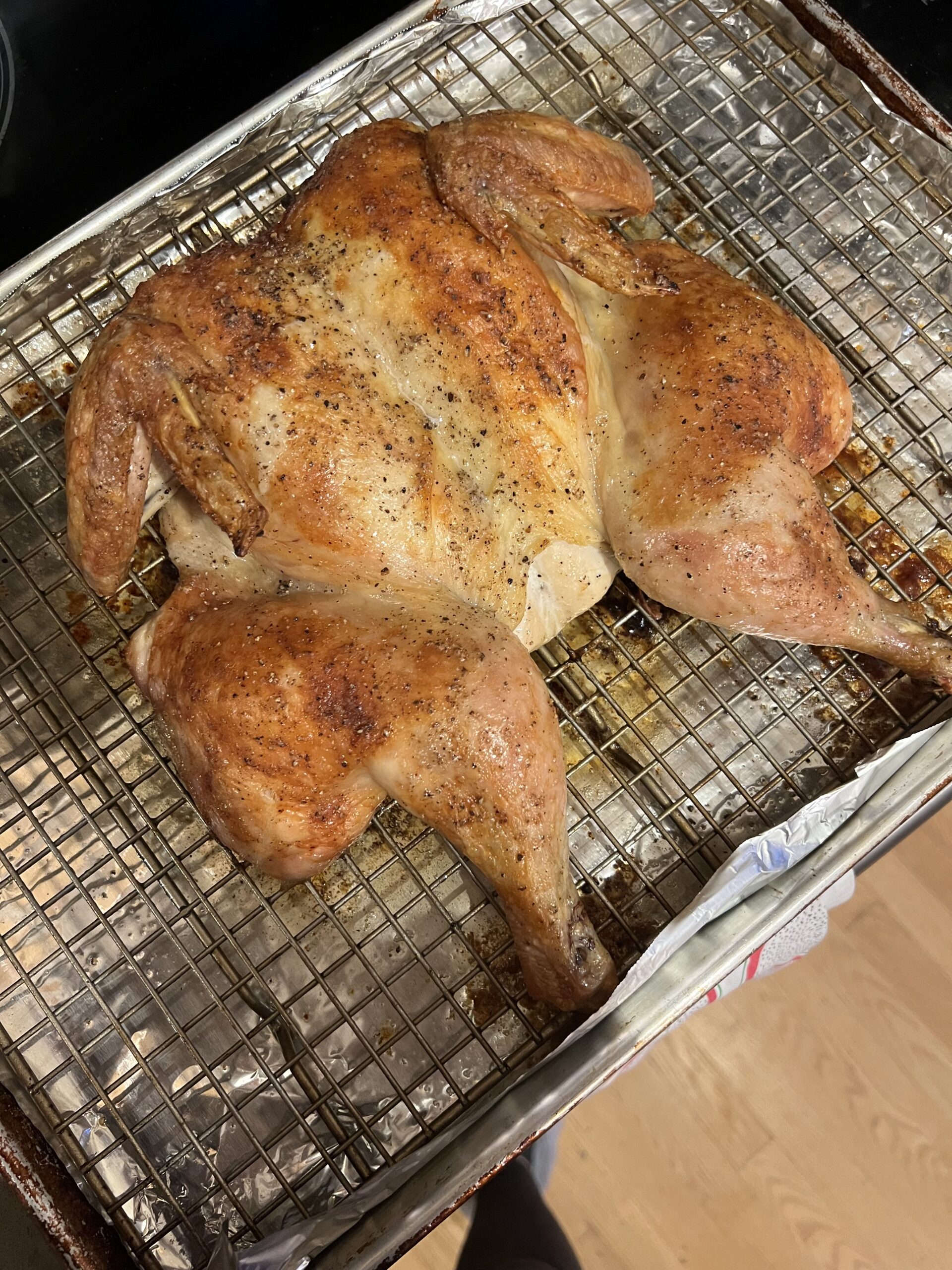


Time: 1 hour 30 minutes
Feeds: 2-4 people
Ingredients:
- 1 whole chicken
- 1 lb small Yukon gold potatoes
- 1 tbsp olive oil
- 4 tbsp butter, softened
- 1/2 tsp garlic powder
- 1/2 tsp paprika
- 1/4 tsp dried thyme
- Kosher salt, to taste
- Freshly ground black pepper, to taste
Directions: Begin by preheating your oven to 425 degrees. Next, in a large, oven proof skillet, add your potatoes whole, and drizzle with olive oil. Shake them around the pan to get them well coated in the olive oil. This is a good point to prepare the compound butter as well for the chicken. Mix together the butter, garlic powder, paprika, and dried thyme. Set aside until you’re ready to rub that under the skin of the chicken.
Remove the chicken from the packaging and make sure all of the liquid drains off and out of the bird. If there are any neck or gizzard pieces inside of the bird, remove those as well. Next, take a pair of kitchen shears and prepare to spatchcock the chicken. With the chicken breast side down on a cutting board, use the kitchen shears to cut down on either side of the backbone to completely remove it. Discard or freeze to save for making chicken stock. Make a small slit in the breast bone either with the tips of your kitchen shears or with a knife. Flip the chicken over and press down firmly on the breast bone to break it the rest of the way. Your chicken should lay very flat at this point.
Next, find the points where the skin has entry points so that you can put the compound butter that was mixed together under the skin of the chicken. These points are usually at the top or fattest part of the breast and at the top of thigh, furthest away from the drumstick. If needed, gently put your fingers or the handle of a wooden spoon in the pocket to loosen it from the meat and make room for the butter. Be very careful to not tear the skin while you’re doing this. At this point, you are ready to spread the butter. Allowing about a quarter of the butter per section, spread the butter as best as you can under the skin of each breast and each thigh portion of the chicken. If you have any additional butter that wasn’t needed under the skin, you can rub it into the outside of the chicken or onto the potatoes that you have in the skillet.
Add the chicken to the skillet, breast side up, with the potatoes nestled around the chicken like in the picture above. At this point, you should season the chicken liberally with salt and pepper to taste. Chicken can take a bit of salt, but of course, season how you like to eat it. Once seasoned, insert an oven safe probe style thermometer into the thickest part of the breast to keep an eye on the temperature of the chicken. Add the skillet to the oven with the thighs facing the back of the oven and leave to roast until the breast reaches the temperature of 155 degrees. This should take about an hour but a thermometer is going to be your best friend in this situation.
Once the chicken reaches 155 degrees in the breast, remove from the skillet and place on a clean cutting board to rest. Turn off the oven but put the skillet with the potatoes back in the oven to stay warm. They shouldn’t need to cook longer but you can test them with a fork – they should be tender. Prepare any vegetable sides you’ve planned to include with the meal and then carve your chicken. Serve with the roasted potatoes and enjoy!
Notes: If you’d prefer to roast the chicken without the potatoes, you can either roast it alone in the skillet all the same or you can set up a roasting pan like I have above in the third picture. I line a baking sheet with foil and then put a cooling rack in there before placing my spatchcocked chicken on top. This lets air flow around the chicken in the oven and help with even cooking. You should still keep the thighs facing toward the back of the oven when roasting on a sheet versus in a skillet as the thighs need to get to a higher temperature of about 180 degrees to be nice and juicy and tender.
